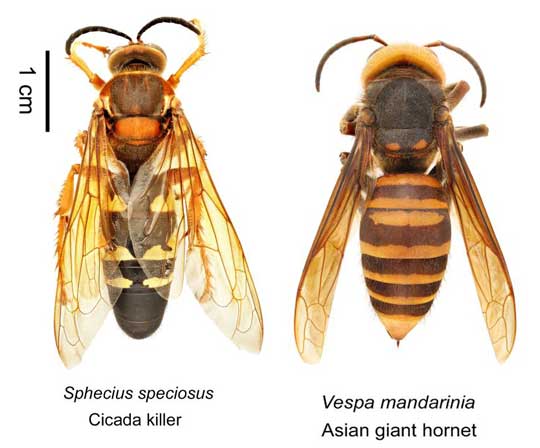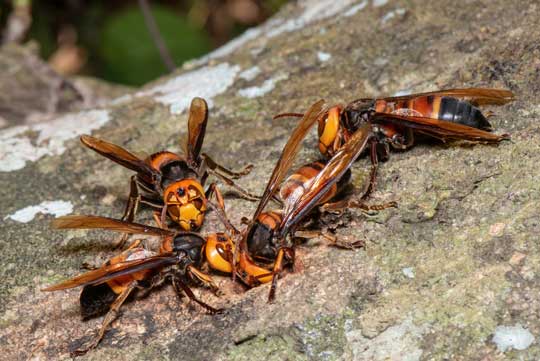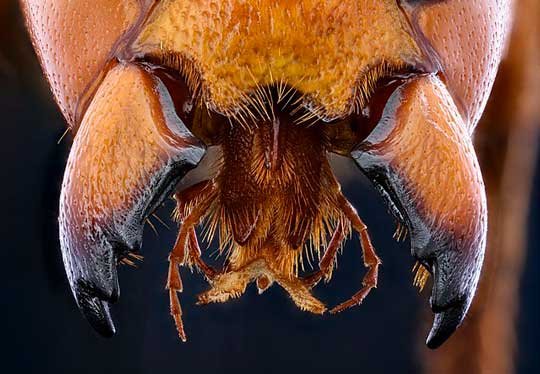|
As a kid, when I was growing up in central Kansas (USA), my friends and I had an exaggerated fear of a large wasp called the cicada killer. Seriously. When we saw one, we would scream "Cicada killer!" and scatter as if our lives were in immediate peril. So, from a young age, I've had a healthy respect for stinging creatures. Now everyone's talking about this mysterious demon called a murder hornet. Wow, what a name. The common name for the insect is actually Asian giant hornet. With all the buzz in the media (see what I did there?), we need to figure out what's real and what's exaggeration. Do we need to scream "murder hornet!" and run for our lives? Let's find out. What the heck is a Murder Hornet? Again, I want to emphasize that murder hornet is not the real name. Therefore, from this point on I will refer to these insects as Asian giant hornets, or just giant hornets. Asian giant hornets (Vespa mandarinia), are the world's largest hornets. They have a wing span of up to 3 inches (76 mm), and the stinger is 1/4 inch (6 mm) long. Their sting can deliver a relatively strong venom, and numerous stings can indeed kill a human (keep in mind this is true of some other hornets, bees, and wasps as well). They have a distinctive yellow head. On average, the cicada killer wasp I mentioned above is actually about the same size or slightly larger than the Asian giant hornet (both can be up to 2 inches long), although there is a lot of variability between individuals of both species. Here they are side by side. The Asian giant hornet is a hornet, and the cicada killer is a wasp—two different groups. Amazing Facts about Asian Giant Hornets First, we need to talk about why these hornets have been so prominent in the news the last few years. Basically, it's because they are spreading. Specifically, they are showing up in the United States, and you know how the American news media can be, right? Is this cause for concern? Yes, but it is not cause for panic, as most people throughout the world have lived in close proximity to various stinging insects all their lives. Let's sort it out. If these hornets can spread to the US, they can spread to other countries too. They live throughout Asia, and they are quite common in Japan. Japan, in fact, is where they were nicknamed murder hornets back in 2008. Giant hornets can be dangerous, but so are other bees, wasps, and hornets, and so are other insects, like mosquitoes. Here are some statistics. During the last two decades, in the United States there has been an average of 62 human deaths per year from bee, wasp, and hornet stings. In Japan, where Asian giant hornets are common, there has been an average of 21 deaths per year from bee, wasp, and hornet stings (giant hornets only cause a portion of those). Throughout all of Asia (a very large population of people), an average of 50 people die per year specifically from Asian giant hornets. Just to put things into perspective, mosquitoes are responsible for millions of yearly deaths worldwide from malaria, dengue fever, and other diseases, according to the World Health Organization. Between 1700 and 1900, about 100,000 Americans were killed by mosquitoes carrying yellow fever. Again, Asian giant hornets can be dangerous, but they are not cause for panic (unless you are a beekeeper... I'll get to that in a moment). Below is a dead giant hornet, to give an idea of its size. Asian giant hornets have a painful and dangerous sting. However, they are not aggressive toward humans unless they feel their nest is threatened. Giant hornets have stingers that are much longer than those of most other wasps, bees, and hornets. Not only that, but because of this insect's size, they can inject seven times more venom than a honeybee can inject. The venom is particularly potent, and people describe it as being similar to getting a hot nail shoved into the skin. The venom contains several kinds of toxins, including a neurotoxin called mandaratoxin. This neurotoxin from the sting of one wasp is enough to kill a mouse about 50% of the time. This is not usually enough to be dangerous to a human unless there are multiple stings. Obviously, an allergy to the venom increases the danger. Research shows that the majority of deaths occur as a result of cardiac arrest or anaphylactic shock resulting from numerous stings. How many stings does it take? It depends on how allergic the person is, but here are some more statistics. Those people who have died were stung an average of 59 times each. Those people who were hospitalized but survived were stung an average of 29 times each. Remember, these are averages... which means some individuals were higher and some were lower. In China, they recommend getting medical attention if stung 10 times or more, and 30 or more stings definitely requires emergency treatment. Are these insects dangerous? Yes, they can be. Should everyone panic and move to an underground bunker? Nope. Most of us already live in areas where there are aggressive bees, wasps, and hornets, and have already learned to be cautious about approaching and threatening their nests. The real danger of these hornets expanding into new territories is that they love to kill bees. In fact, that's how they actually got the nickname of murder hornets. Bees are essential pollinators. Beekeepers (and wild bees) help sustain dozens of essential agricultural crops, as well as countless non-agricultural native plants. However, Asian giant hornets love killing bees! And they love honey. When a giant hornet finds a beehive, it releases a chemical that tells its buddies where the hive is, and soon an entire brigade of giant hornets descends upon the beehive like demons of the apocalypse. At five times the size of a honeybee, each giant hornet can kill 40 bees per minute. The hornets have jaws specially adapted for ripping the bees' heads from their bodies (see these "mandibles of death" below). Incredibly, a few dozen giant hornets can wipe out an entire colony of over 10,000 honeybees in just a few hours. This could be devastating to bee populations (not to mention to the livelihood of beekeepers and honey producers). Interestingly, Japanese honeybees, having evolved where giant hornets are common, have adapted defenses to this kind of attack. When they detect a single giant hornet near their hive, they attack en masse before the hornet can release its chemical to attract other hornets. The bees are too small to kill the hornet by fighting, so instead they pile onto it, enveloping it in a mass of bees, then they vibrate their bodies at an extremely fast rate. This creates so much heat that they roast the hornet alive. Awesome, huh? Check out this video about how Japanese honeybees do this. So, for many reasons, giant hornets are not welcome outside of their native range—not in the United States nor anywhere else. Fortunately, there are ways to get rid of these invasive murderers. Poisons, baited traps, controlled fires, and strategic uses of screens over nesting areas are possible eradication methods. Even though these creatures are unwanted outside of their native range, they are still awesome animals. They are amazing apex insect predators, with impressive adaptations. Consider sharks... sharks are awesome animals, although you wouldn't want a bunch of them to invade your neighborhood swimming pool. So, the Murder Hornet deserves a place in the F.A.H.O.F. (Fabulous Animal Hall of Fame). FUN FACT: The word fabulous originated in the early 1400s, from the Latin word fabulosus. Its original meaning was "mythical, legendary." In other words, it implied that something was not actually true (this seems appropriate for the "murder hornet" because of all the misinformation about them). In about 1600, it began to be used to mean "incredible," as in "enormous, immense, amazing" (again, appropriate for this animal). Finally, in the 1950s, it was changed to mean simply "marvelous, terrific." A shortened form of it, fab, became popular in 1963 to refer to The Beatles (the Fab Four). So, fabulous is another way to say awesome! Photo Credits:
Asian giant hornet on white background - DepositPhotos Asian giant hornet in hand - NUMBER7isBEST, CC BY-SA 4.0, via Wikimedia Commons Four hornets on a rock - DepositPhotos Giant hornet mandibles - USGS Bee Inventory and Monitoring Lab from Beltsville, Maryland, USA, Public domain, via Wikimedia Commons
0 Comments
Leave a Reply. |
Stan's Cogitations
Everyone needs a creative outlet. That's why I write. Archives
July 2024
|






 RSS Feed
RSS Feed